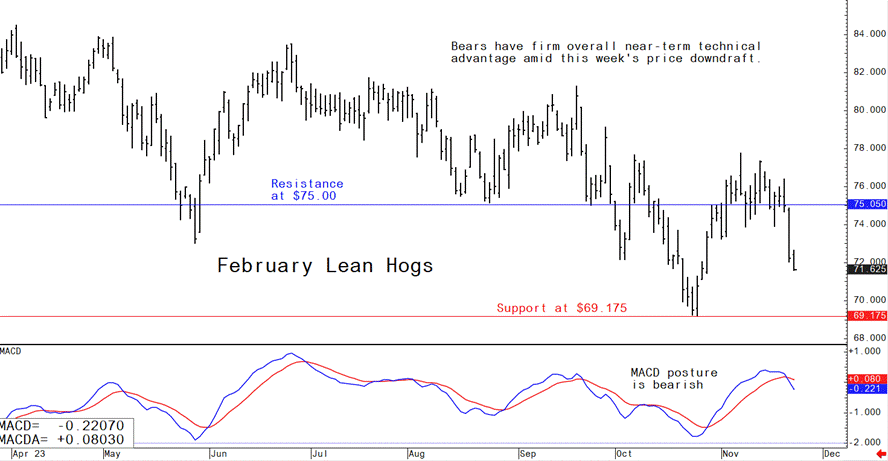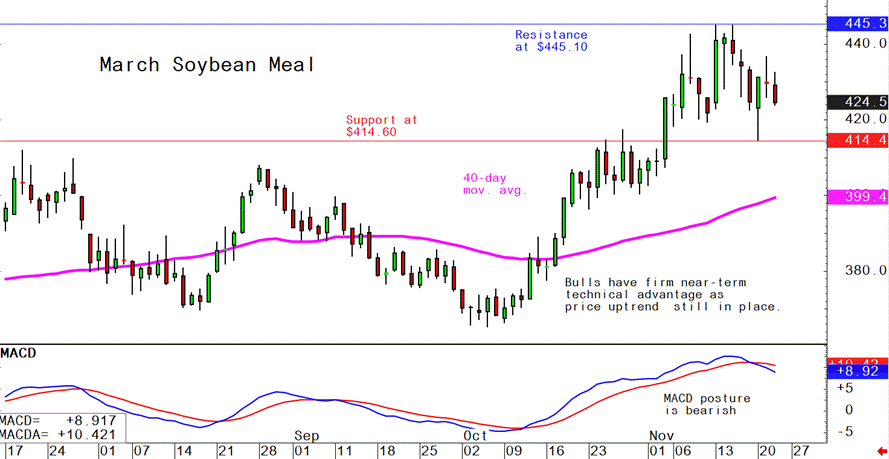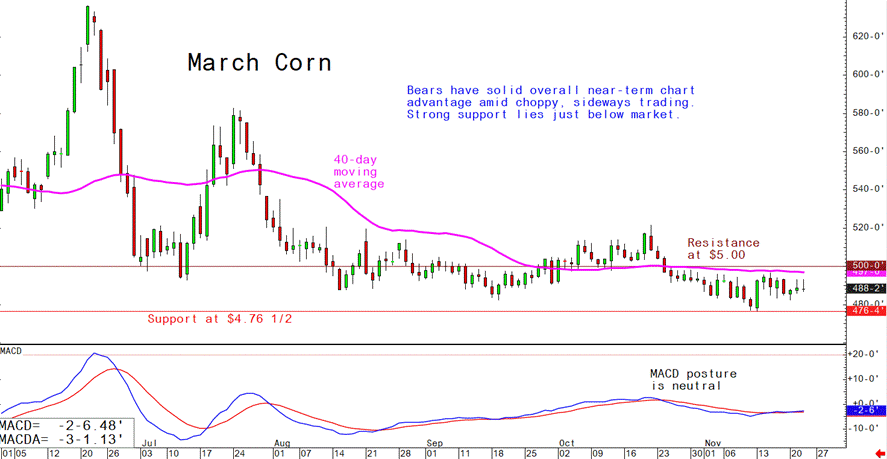



Pig outlook - Lean hog bears seize technical control, 2nd case of ASF in Hong Kong, Prop 12 compliance
Analyst Jim Wyckoff shares pig news from around the worldFebruary lean hog futures Wednesday dropped to a three-week low and prices have careened lower this week, producing serious near-term technical damage to suggest more downside price pressure in the near term. Pork cutout value posted a new for-the-move low this week, marking the lowest value since early June. The CME lean hog index fell another 34 cents to $74.18, as of Nov. 20, a fresh seasonal low. Cash and wholesale fundamentals continue to weaken, which should continue to weigh on cash and futures prices in the near term. The lean hog market bulls can still point to generally good consumer demand for pork, amid historically elevated beef prices, which should keep a floor under present hog and pork price levels. Hog slaughter will likely rise as the industry gets back to work after the Thanksgiving holiday, with the weekly total probably reaching its annual peak during the week ending Dec. 16. However, wholesale ham demand is likely to be strongest in mid-December, ahead of the holidays.
Hong Kong reports second ASF case in a month
Hong Kong has ordered the culling of almost two thousand pigs after confirming a second case of African swine fever (ASF) in a month, according to a report from Reuters.
The Agriculture, Fisheries and Conservation Department (AFCD) on Thursday said it planned to cull around 1,900 pigs from one herd on Nov. 25 after the virus was discovered at a local pig farm. The licensed pig farm at Lau Fau Shan, in the rural Yuen Long area near the border with mainland China, tested positive for the ASF virus after staff took samples from 62 pigs.
"The present case does not affect the operation of local slaughterhouses nor the overall supply of live pigs," the department spokesperson said in a statement, adding that it will stringently conduct cleaning and keep local pig farms under close surveillance.
Earlier this month, authorities ordered the culling of around 5,600 pigs after detecting an ASF outbreak at a farm in Yuen Long. It was not immediately clear if the second case was found at the same farm or a different one.
China's sow herd declines for tenth consecutive month
Data from the Chinese Ministry of Agriculture and Rural Affairs revealed that China's sow herd has decreased to 42.1 million, down from 42.4 million in September, marking a tenth consecutive month of declines. However, state broadcaster CCTV indicated that the government still considers this level to be higher than necessary, as pork consumption has been lower than anticipated, and productivity has continued to rise. This situation has put pressure on hog prices in China, which are now 42% lower than they were a year ago.
The ministry has stated its intention to "stabilize" the situation and encourage a more reasonable level of production. However, specific details about the policy shifts that may be implemented to achieve this goal have not been provided.
USDA this week began reporting on number of US hogs raised in compliance with animal confinement legislation
This reporting includes California's Proposition 12 for the first time. Prop 12 requires that pork produced on farms outside California provides breeding sows with at least 24 square feet of floor space, the same as required within the state.
This new classification will be included in the National Weekly Direct Swine Non-Carcass Merit Premium report, according to the Agricultural Marketing Service (AMS). Until now, ACL-compliant hogs were categorized as "other," which included hogs raised under various programs focusing on animal welfare, antibiotics, diet, genetics, meat quality, process verification, sow housing, and weight. The volume of ACL-compliant hogs under federal livestock reporting laws has grown large enough to warrant a separate listing, as per AMS.
USDA said this addition will provide valuable information to stakeholders in the pork industry, allowing them to make informed decisions related to ACL-compliant hogs. The National Pork Producers Council has been involved in advocating for this reporting and has stayed engaged with the USDA's Agricultural Marketing Service throughout the process. California has set Jan. 1 as the compliance date for Prop 12.
How China’s African swine fever outbreaks affected global pork markets
Animal disease outbreaks can cause unexpected changes in supply and demand for meat and other livestock products. These changes can result in price fluctua[1]tions and disruptions in foreign trade that create uncertainty in international markets. Diseases that spread across national boundaries and result in the culling of large numbers of animals in major producing countries are especially disruptive.
This is what happened when African swine fever (ASF) spread from Europe to China in 2018—one of the largest animal disease incidents ever. The outbreak reduced China’s pork supply, and Chinese pork prices more than doubled to reach record levels. As China accounts for nearly half of the pork produced and consumed in the world, this report investigates the degree to which China’s reduced pork supply affected pork-exporting countries.
What Did the Study Find? The ASF virus moved from Europe to China in August 2018, then spread rapidly throughout the country. The virus impacted China’s pork supply more than indicated by the number of officially reported outbreaks.
Following China’s first ASF cases, its swine herd went through a 30-month cycle of decline and recovery from the third quarter of 2018 (Q3) to 2021 (Q1).
China lost an estimated 27.9 million metric tons of its pork production during the 30-month cycle. China imported a record volume of pork during those months, but the imports replaced only one-fifth of lost production. Thus, China experienced shortfalls in pork supplies for about 18 months, concentrated during the second half of 2019 and most of 2020.
Increases in pork prices lagged the spread of the disease. Pork prices in China more than doubled, with most of the increase occurring about a year after the initial outbreaks. Pork prices remained at a high level for 14 months and then fell rapidly during 2021. Pork prices returned to near their pre-ASF level about 38 months after the first outbreaks.
Pork exports to China surged during 2019–20. China accounted for 45 percent of world pork imports in 2020.
A total of 31 countries exported pork to China, but the European Union accounted for 58 percent of the exports. The United States was the second-leading pork exporter to China, with a 15 percent share, despite trade tensions that coincided with China’s ASF outbreaks.
During the 14-month peak in China’s import demand, the share of pork exported to China increased for top pork-exporting countries. Sales of higher value cuts grew fastest.
Impacts on pork markets outside of China were relatively modest. For example, increases in pork prices in three leading pork exporting countries (the United States, Germany, and Spain) were relatively brief and much smaller in magnitude than price increases in China.
Volatility in China’s pork market is an ongoing source of uncertainty for exporters despite the rebound in China’s production.
The next week’s likely high-low price trading ranges:
February lean hog futures--$69.00 to $75.00 and with a sideways-lower bias
March soybean meal futures--$415.00 to $450.00, and with a sideways bias
March corn futures--$4.76 1/2 to $5.00 and a sideways bias
Latest analytical daily charts lean hog, soybean meal and corn futures










